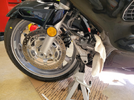When you say 'SMC cylinder done' - what exactly do you mean ?
You dont have much time, so I'll throw suggestions.
1. Your SMC isn't sealing. and is not able to return properly. eg due to an oval bore.
The SMC is moved when you brake, but it cannot return by itself. Applying the brake pedal puts pressure in the line behind and helps move the piston back, resulting in the soft pedal feel. Typically, you can tell this is happening if you pump the pedal and it stays firm for a while.
This will not last forever. At some point it will fail drastically, if the piston cannot clear the compensation port. If the piston has stopped sealing due to an oval bore, then it will probably stay like this forever. I have seen this situation before.
2. Did you fit a service kit ? Did you ensure that the seals went in properly - flared open end first ?
3. You still have air in the rear system. And I can probably explain where it may be hiding:
The rear brake line goes from the rear master cylinder to the rear centre piston. That is easy to bleed, so I am guessing that it is not hiding in that line.
Another line goes from the rear master cylinder, forward, up a flexible hose and down the front right fork leg. It splits at the top of the mudguard, one line going to the front right centre piston, the other across the mudguard to the front left centre piston.
The front left centre piston has a very short hose to the inlet of the SMC.
Fluid then passes through the SMC, but it can only do this if the SMC is relaxed.
You said that when you apply the front brake, the pedal is firm. Since the front brake line and rear brake line are not connected, so this isn't possible if the bike is stationary, I will assume that this happens when you are riding. The front braking operates the SMC when the bike is moving and this effectively prevents the fluid from the rear brake passing through the SMC.
From this, it seems logical that there is no air in the line from the pedal to the front left centre piston bleed valve.
So the air is likely to be from there onwards. ie up the left fork leg, back across the mudguard, through the proportional control valve (PCV), past the bleed valve near the PCV on the right hand side under the tank near the ignition coil, and then down to the two outer pistons in the rear caliper.
The most likely place for the air is in the flexible hose which forms an 'n' shaped loop behind the upper fork legs. Get a vacuum pump on the Pcv bleed valve and let it suck fluid while you flex and tap that hose. ( there are two hoses, you need to flex the correct one).
I think that It is either going to be a VERY long night, or you are going to miss your MOT !
 The usual format from me - Description, some useful photos and a few tips and tricks to help you to avoid the normal 'Doh!' moments -
The usual format from me - Description, some useful photos and a few tips and tricks to help you to avoid the normal 'Doh!' moments -




